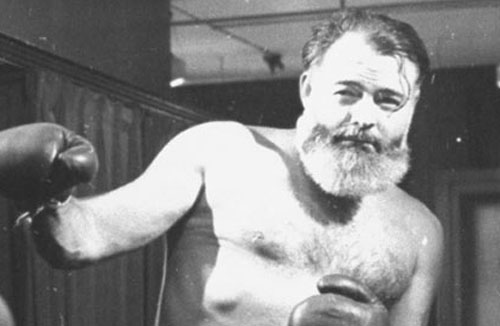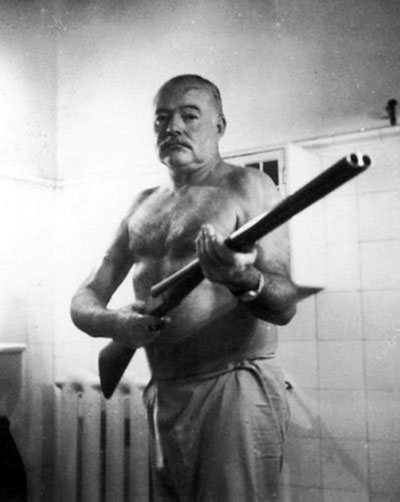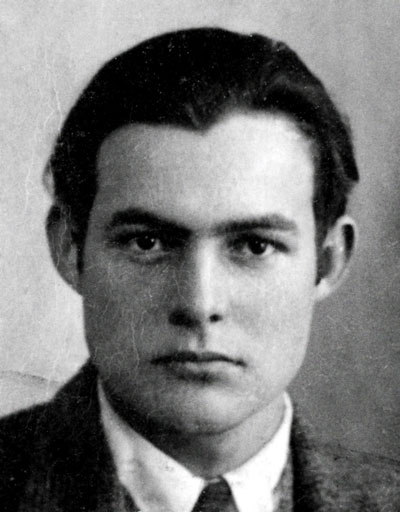Ernest Hemingway
The first thing I read by Ernest Hemingway was a short story called ‘Hills Like White Elephants’. I had never read anything like it before. It kind of changed everything for me. I threw away my thesaurus that day.
Okay, I lied; I didn’t throw my thesaurus away. I didn’t have one. Maybe if I had one I might have thrown it away but really I can’t imagine myself being so erratic and wasteful. Also, the Internet is a thing. But I did throw my desire to use obscure words away. There isn’t a single strange word in ‘Hills Like White Elephants’ and there isn’t a single word in it that I would change.
 Like the character ‘the American’ in the story, Hemingway and most of his male protagonists are men. Like proper man men. Like proper beer-drinking, bare-knuckle fighting, fishing, war-mongering, not-communicating-with-women-properly men. Or at least this is how he is often portrayed, and how he allowed himself to be portrayed during his lifetime. He found that his book sales were healthy when people thought that all of his characters were based on himself and his mad adventures. So he played the part. But really, the man was a poet. He was as emotional as they come. His emotions were hyper emotions, he felt more than most people. So when he was happy he was extremely happy and he made other people happy. But when he felt sad, he was properly sad. When he felt despair he shot himself in the face with his ‘favourite’ shotgun.
Like the character ‘the American’ in the story, Hemingway and most of his male protagonists are men. Like proper man men. Like proper beer-drinking, bare-knuckle fighting, fishing, war-mongering, not-communicating-with-women-properly men. Or at least this is how he is often portrayed, and how he allowed himself to be portrayed during his lifetime. He found that his book sales were healthy when people thought that all of his characters were based on himself and his mad adventures. So he played the part. But really, the man was a poet. He was as emotional as they come. His emotions were hyper emotions, he felt more than most people. So when he was happy he was extremely happy and he made other people happy. But when he felt sad, he was properly sad. When he felt despair he shot himself in the face with his ‘favourite’ shotgun.

The first time I read the story I thought it was an interesting conversation between a man and a woman. But I knew there was something more to it. I read it again. I started to get it. I’ve now read it about seven thousand times and the whole thing is just fascinating. Everything means something. If you haven’t read it, I recommend you drop everything and read it immediately. It’s very short. And very very powerful.
It’s set in a train station, which straight away sets it up. The characters are in between two places. They’re physically halfway between Barcelona and Madrid, and metaphorically between two tough decisions. They are at a crossroads in their relationship. It transpires (after a few readings) that the woman (referred to as ‘Jig’) is pregnant, and what they’re actually talking about is getting an abortion.
“It’s really an awfully simple operation, Jig,” the man said. “It’s not really anything. It’s just to let the air in.”
The man is trying to convince his girlfriend to have the operation while trying to seem like it’s completely up to her. The woman is indecisive, unsure about what to do with the baby. This is inherent in her character as she is indecisive about everything else too, including whether the landscape looks one way or another, where to sit, what to drink etc.
On one side of the train tracks are the white hills that are bright in the sunlight, and very striking. The girl says that they look like white elephants. The white elephant is a symbol for something that nobody wants, like the unplanned baby. The other side of the station is barren desolate land, this would be, perhaps, their life without the baby. At the beginning the girl is edging towards not wanting the baby, but when she starts leaning the other way she changes her mind and decides that the hills don’t actually look like white elephants. She walks around the bar and spending some time looking at the landscape to the front, and the landscape to the rear. The man always sits in the middle.
The man is quite certain about everything. He is the strong male Hemingway character. He knows what he wants to drink, he knows that he doesn’t want the baby, he knows where to sit. Furthermore, the girl is more dependent on him than he is on her. [pullquote] They choose to drink to avoid talking about it. Eventually the more they drink the more they talk, but they never really listen to each other. They both say their own parts, but really, they’re not communicating with each other.[/pullquote] This is highlighted by the Spanish-speaking bar lady with whom the man can communicate, but the girl needs him to translate. At the beginning the couple are clearly hesitant to talk about the issue, or the ‘elephant in the room’, if you like, the white elephant. They choose to drink to avoid talking about it. Eventually the more they drink the more they talk, but they never really listen to each other. They both say their own parts, but really, they’re not communicating with each other. The woman grows tired of it and ends up pleading with the American to stop talking. She says ‘please’ seven times in a row.
In the end, the man has brought their bags (heavy baggage) to one side of the track and then returns to finish his drink at the bar. The other people in the room are described as ‘reasonable people’, which means he considers the girl to be unreasonable. The woman sits at a table. They are drinking separately and this signifies that they will probably go their separate ways.
This article is probably already longer than the story so I should shut up. Basically, I think I could talk about that story all day. I’m just trying to show you how he made such great stories out of so little. But Hemingway is great. Go and read everything by him. I recommend starting with ‘Hills Like White Elephants’ and then reading all of his other short stories. I have The Complete Short Stories of Ernest Hemingway and it’s great to dip in and out of. The Sun Also Rises, A Farewell To Arms, For Whom the Bell Tolls and The Old Man and The Sea are all also mind-blowing.
I should tell you a small bit about Ernie. I’ll do that now.
I’m not the only one to appreciate him. The man won both the Nobel Prize for literature and the Pulitzer Prize. He is considered by many to be the most important writer in the modern era. He was born in 1899, which is a year many of HeadStuff’s readers won’t remember. He was an outdoorsy type, he loved nature and paradoxically, hunting (killing nature for craic). But he was the type of guy that liked an adventure, he wasn’t afraid of stuff. He got himself as close to both of the world wars as he possibly could (whereas I would be doing precisely the opposite). He literally got himself into the wars for material to write about. He got so close that a mortar did what mortars do near his legs and he ended up with two hundred and twenty-seven wounds on his legs. He spent the rest of that war in bed. Eventually he wrote a little something called A Farewell To Arms so maybe it was worth it?

Ernest Hemingway is absolutely one of my favourite writers. His style has been often copied but never really bettered. It might seem like an old style now, or very common, but in his time it was brand new. He was avant-garde, a radical, he was experimental, and not everyone got what he was doing, or understood why he was so popular. He probably did more to change literature than any other writer. Including James Joyce, about whom Ernest said, “Joyce has written a most goddamn wonderful book” (Ulysses).
He also had a brilliant burn on his contemporary William Faulkner, a writer of a very different style:
“Poor Faulkner. Does he really think big emotions come from big words?”
Take that, Faulkner. If there was a talent show type thing, an X Factor thing where Hemingway and Faulkner were judges, I’d watch that. In pretty much all other circumstances I wouldn’t watch it.
Ernie, my pal, was a complicated man, and very competitive. He suspected that his friend F. Scott Fitzgerald had written ‘the great American novel’ in The Great Gatsby but he just saw that as a challenge. He was a reporter and a short story writer, but he moved to novels because that’s where all the prestige was, and that’s how you got onto bestseller lists. Both of which he accomplished. Ezra Pound said to him, “make it new”. Which might seem like an arbitrary or simple little nugget. But if you think about it, it’s extraordinarily difficult. How do you change something that’s so old and enormous and qualified by greats? I have no idea how you do it, but same as when Muddy Waters picked up an electric guitar in Chicago in the early ’50s and changed music, Hemingway changed literature.
Here’s an experiment to try at home: change literature. Invent a new style that changes everything. Let me know how you get on. I look forward to hearing from you never.
 I’ll stop gushing about the man now. I’ll just tell you one last story about when he bought his house, the very cool Finca Vigia in Cuba. He pulled up outside the gates of the house. There were local kids playing baseball outside the grounds with a ball made of rags and a bat made out of a broom handle. He struggled to open the gate and the kids came over and helped him. He asked them why didn’t they play on the grass inside the fence? They said that the gardener would chase them with a machete. (Which makes me feel really bad about disobeying “please keep off the grass” signs all my life). Hemingway said that if he bought the house he’d let them play baseball on the inside of the fence. He bought the house. He started a baseball team for those local kids and his sons, he bought enough equipment for two teams.
I’ll stop gushing about the man now. I’ll just tell you one last story about when he bought his house, the very cool Finca Vigia in Cuba. He pulled up outside the gates of the house. There were local kids playing baseball outside the grounds with a ball made of rags and a bat made out of a broom handle. He struggled to open the gate and the kids came over and helped him. He asked them why didn’t they play on the grass inside the fence? They said that the gardener would chase them with a machete. (Which makes me feel really bad about disobeying “please keep off the grass” signs all my life). Hemingway said that if he bought the house he’d let them play baseball on the inside of the fence. He bought the house. He started a baseball team for those local kids and his sons, he bought enough equipment for two teams.
As if that wasn’t enough, he gave writers and artists everywhere this gem of advice: “The first draft of everything is shit.”
Or you can use my version: “The first twenty drafts of everything are shit.”
Featured Images:
edgardaily.com
openculture.com
fightland.vice.com
therumpus.net
wikipedia.com

